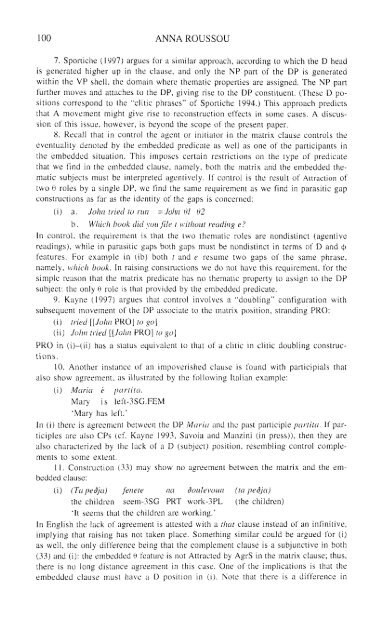Comparative Syntax of the Balkan Languages (Oxford ... - Cryptm.org
Comparative Syntax of the Balkan Languages (Oxford ... - Cryptm.org
Comparative Syntax of the Balkan Languages (Oxford ... - Cryptm.org
- No tags were found...
You also want an ePaper? Increase the reach of your titles
YUMPU automatically turns print PDFs into web optimized ePapers that Google loves.
100 ANNAROUSSOU7. Sportiche (1997) argues for a similar approach, according to which <strong>the</strong> D headis generated higher up in <strong>the</strong> clause, and only <strong>the</strong> NP part <strong>of</strong> <strong>the</strong> DP is generatedwithin <strong>the</strong> VP shell, <strong>the</strong> domain where <strong>the</strong>matic properties are assigned. The NP partfur<strong>the</strong>r moves and attaches to <strong>the</strong> DP, giving rise to <strong>the</strong> DP constituent. (These D positionscorrespond to <strong>the</strong> "clitic phrases" <strong>of</strong> Sportiche 1994.) This approach predictsthat A movement might give rise to reconstruction effects in some cases. A discussion<strong>of</strong> this issue, however, is beyond <strong>the</strong> scope <strong>of</strong> <strong>the</strong> present paper.8. Recall that in control <strong>the</strong> agent or initiator in <strong>the</strong> matrix clause controls <strong>the</strong>eventuality denoted by <strong>the</strong> embedded predicate as well as one <strong>of</strong> <strong>the</strong> participants in<strong>the</strong> embedded situation. This imposes certain restrictions on <strong>the</strong> type <strong>of</strong> predicatethat we find in <strong>the</strong> embedded clause, namely, both <strong>the</strong> matrix and <strong>the</strong> embedded <strong>the</strong>maticsubjects must be interpreted agentively. If control is <strong>the</strong> result <strong>of</strong> Attraction <strong>of</strong>two 6 roles by a single DP, we find <strong>the</strong> same requirement as we find in parasitic gapconstructions as far as <strong>the</strong> identity <strong>of</strong> <strong>the</strong> gaps is concerned:(i) a. John iried to run = John t)l 02b. Which book did you file t without reading e?In control, <strong>the</strong> requirement is that <strong>the</strong> two <strong>the</strong>matic roles are nondistinct (agentivereadings), while in parasitic gaps both gaps must be nondistinct in terms <strong>of</strong> D and tj>features. For example in (ib) both t and e resume two gaps <strong>of</strong> <strong>the</strong> same phrase,namely, which book. In raising constructions we do not have this requirement, for <strong>the</strong>simple reason that <strong>the</strong> matrix predicate has no <strong>the</strong>matic property to assign to <strong>the</strong> DPsubject: <strong>the</strong> only 6 role is that provided by <strong>the</strong> embedded predicate.9. Kayne (1997) argues that control involves a "doubling" configuration withsubsequent movement <strong>of</strong> <strong>the</strong> DP associate to <strong>the</strong> matrix position, stranding PRO:(i) tried [[John PRO] logo](ii) John tried [[Joint PRO] to go\PRO in (i)-(ii) has a status equivalent to that <strong>of</strong> a clitic in clitic doubling constructions.10. Ano<strong>the</strong>r instance <strong>of</strong> an impoverished clause is found with participials thatalso show agreement, as illustrated by <strong>the</strong> following Italian example:(i) Maria e partita.Mary is left-3SG.FEM'Mary has left.'In (i) <strong>the</strong>re is agreement between <strong>the</strong> DP Maria and <strong>the</strong> past participle partita. If participlesare also CPs (cf. Kayne 1993, Savoia and Manzini (in press)), <strong>the</strong>n <strong>the</strong>y arealso characterized by <strong>the</strong> lack <strong>of</strong> a D (subject) position, resembling control complementsto some extent.11. Construction (33) may show no agreement between <strong>the</strong> matrix and <strong>the</strong> embeddedclause:(i) (Ta pedja) fenete na doulevoun (ta pedja)<strong>the</strong> children seem-3SG PRT work-3PL (<strong>the</strong> children)'It seems that <strong>the</strong> children are working.'In English <strong>the</strong> lack <strong>of</strong> agreement is attested with a that clause instead <strong>of</strong> an infinitive,implying that raising has not taken place. Something similar could be argued for (i)as well, <strong>the</strong> only difference being that <strong>the</strong> complement clause is a subjunctive in both(33) and (i): <strong>the</strong> embedded b feature is not Attracted by AgrS in <strong>the</strong> matrix clause; thus,<strong>the</strong>re is no long distance agreement in this case. One <strong>of</strong> <strong>the</strong> implications is that <strong>the</strong>embedded clause must have a D position in (i). Note that <strong>the</strong>re is a difference in
















